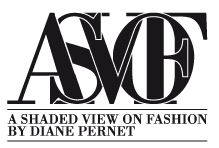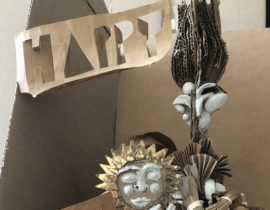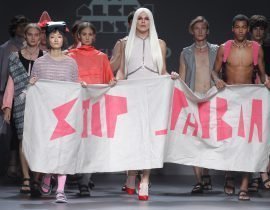Dear Shaded Viewers,
The original concept of couture salons was often wildly creative at Poiret, or Vionnet, but the legend is that we are in a Hotel Particuliere in Paris with gilded boiseries and chandeliers. Well, although we can be anywhere from a huge industrial basement to an all white gallery, this season the principle behind little gilt chair and the salon with chandeliers idea seemed much is favour as a concept. Focus on the clothes for these couturiers was paramount, the key in choice venue is intimacy to see the clothes and their fabrics and details. The other element which seemed important was a variety of lines to suit the clients, it’s no longer the single seasonal statement of “Christian Dior says the “H” line,” it is about dressing lots of different people, and couture can, and should be, for anyone who can afford it.
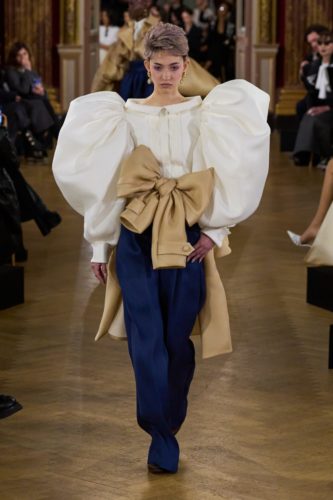
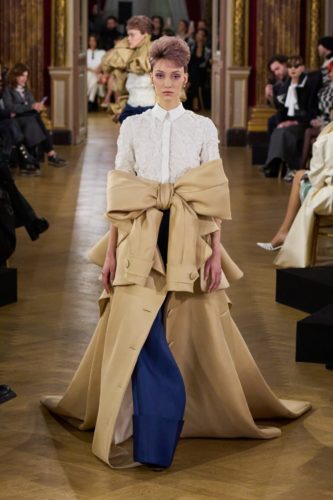
Viktor & Rolf
In the salon that Yves Saint Laurent traditionally showed his couture every season, in the gilded Second Empire ballroom Dutch duo Viktor and Rolf sent out a truly couture offering but of course with their own creative twists. The soundtrack seems to be announcing the outfits, but in fact was repeating the same again and again, the collection basics. Le Trench, Chemise blanc, pantalon bleu marine – a trench, a white shirt, and a pair of navy trousers. It’s amazing what these two can whisk up out of these seemingly conventional garments, and how many variations within this tightly edited trio they could offer. Volumes of course were there with huge sleeves and pouter pigeon bosoms, but they also offered a trench covered in degradee pleated ruffles, and a trench where all the threads were left forming fringe, softly draped trousers, swirling Second Empire trains and slender pared down silhouettes boardering on the conventional. An amazing, beige crumpled silk Empire jacket surmounted a billowing Merveilleuses dress in white organza, a Balenciagaesque bubble in camel revealed a fluttering white shirt hem and then flared navy trousers forming a triangular silhouette. It was couture salon magic, and to be honest I loved it. As usual with strong statements not everyone did but that’s brilliant creative work for you, you can’t sit on the fence. In the gilded salons under the sparkling chandeliers the clothes fitted perfectly into the traditions of haute couture but reimagined with a quirkiness that makes them anything but traditional.
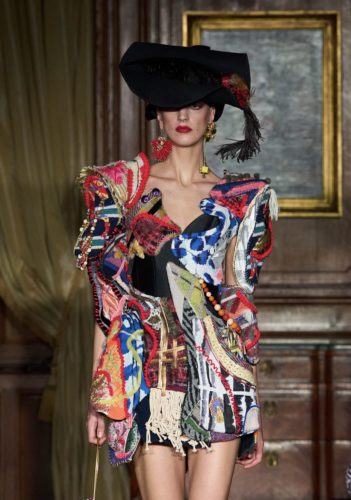
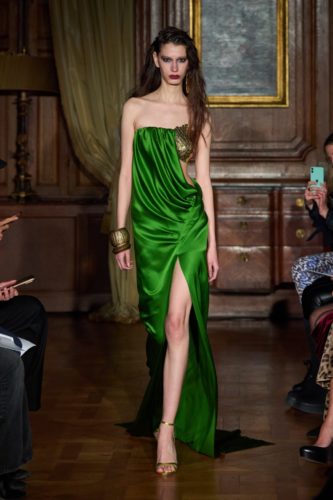
Ronald van der Kemp
Although the clothes have the concept of recycling, upcycling, and reinvention, they remain the product of couture training and methods. The show was at Hôtel d’Avaray, Residency de l’ambassadeur des Pays-Bas in a series of salons.
As each model passes, we wonder at the cut, the construction, and the line, from short and ebullient through to slender and pensive the collection is created for a range of clients and the workmanship encompasses the traditional, yet with far from traditional applications and resources.A thunder grey toga was draped over a patchwork bustier seemingly constructed from pieces of Cloisonné. A slender shimmering leopard evening dress had mismatched sleeves of brocade and rich lace, a short, flounced dress of wild plaid taffeta had a huge bow of Art Nouveau silk, and a waisted little tuxedo jacket was not only in black but had an origami peplum of a variety of black evening wear fabrics catching the light. This extraordinary variety of textures lends a special sheen and gloss to the collection where craft, and attention to the details of every angle of each look, personifies the couture approach. Often after the show stories are revealed of the origins of the fabrics, the techniques and the exceptional skills needed to transform seemingly unyielding or fragile ingredients into a cohesive entity. It’s a special skill that Ronald van der Kemp, and his team have perfected across the seasons. It is true couture, but it combines both the past and the future in its use of techniques that are established, and also inventing new ways of creating these couture masterpieces, indeed works of art.
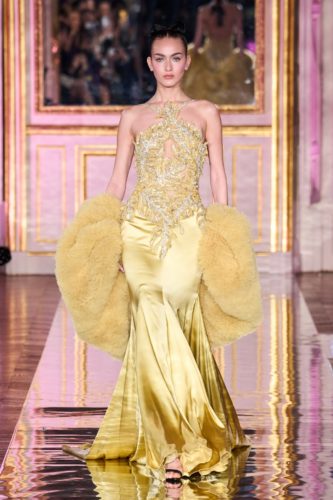
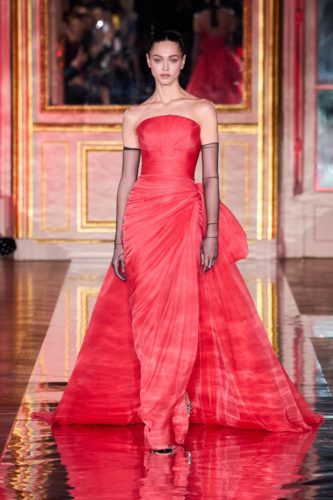
Zuhair Murad
Zuhair Murad moved his venue and in the smaller chandelier hung rooms of Hôtel Pozzo di Borgo at 51, rue de l’Université he offered a delightful and fresh collection of couture. Light of touch and with both slender sexiness and ingenue prettiness there was a hint of the glamour of Diana Vreeland’s Vogue years. The key stories were delicious colours from a hot coral through to powder blue, and spearmint green through to bubblegum pink, the sweeping back views which had a hint of Balenciaga and Mona Harrison Williams at times, and this season especially, how glittering embroidery was part of many looks but not predominant. Zuhair Murad is a proper couturier who fits and drapes and worries about each garment, he can often be seen after the show when being photographed with the models, rearranging a skirts folds, or adjusting a shoulder. It produces pieces like the oyster silk satin dress with a floating back skirt panel and a shoulder framing collar like the petals of a huge flower, or the sugar pink dress whose bodice featured a cockade covering the entire bodice and a skirt like huge tulip petals folding over each other, or the azure blue draped crepe dress secured with clusters of diamond encrusted leaves and with two long streamers of fabric twisting around the arms. Couture requires focus and attention, it demands great fabrics, an individual colour sense, beautiful lines, and every detail in harmony. This collection certainly achieved all these, and more.
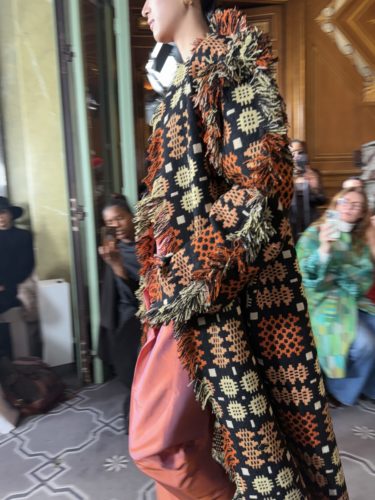
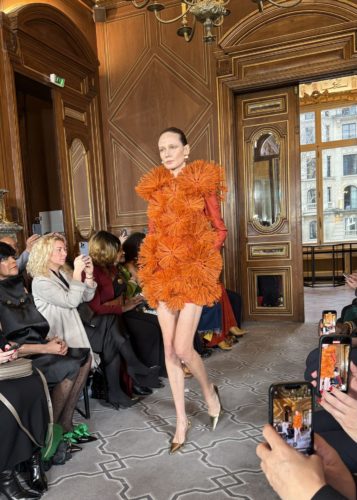
Imane Ayissi
Imane Ayissi embraces the entire concept of couture and then adds his own background and cultural extras, craft, texture, colour, and a certain dancing movement to the pieces. There was less raffia and fringes this season but there were some great pieces in a collection that offered amazing variety in silhouette and line. There were soft fluid robes in prints, there were simple linear coats and there was a bold trapeze shape falling from the empire line, as well as the long fitted couture silhouette from bust to hips exploding into a full skirt. There was even slender with drape and extra slender formed of sparkling flowers outlining the body. This variety was not confused or muddled, it was about reacting to fluid fabrics and stiff fabrics, heavily patterned or woven fabrics or simple satins and crepes or rustling crisp shantung and silks. This is what a true couturier does, he offers the fabric in the appropriate shape and garment, and he offers the clients options to suit their figures and lives. I guess for me the standout was deep rich olive green, slender silk shantung dress which was swathed with a vast asymmetrical matching panel wrapped around it forming both a bow and a train. It swept between the rows making that sound that only rich couture fabrics make and as it progressed through the salons it announced itself as a couture dress to wear to a gala, an awards ceremony or simply to be a star. Now that’s couture.
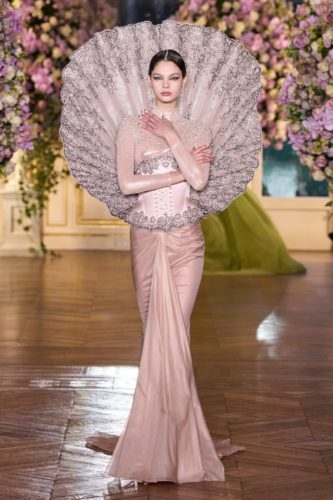
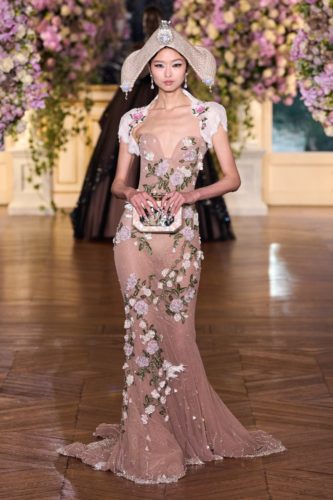
Miss Sohee
Miss Sohee made her couture debut. It was an enormous success, and it’s clear from the images why, but if you were in the room, wow. As each model entered the interlinked salons, she strode with a slow but purposeful presence which was both a reminder of the golden days of Irving Penn and Richard Avedon, but also of models like Carmen, Dovima and Sunny Hartnett. As Carmen dell’Orifice always says “Make a shape.” From the fragile high heeled shoes to the brilliant confections on their heads, these were looks to demand not just attention, but the very centre of our focus. From my seat I watched as each model descended a marble staircase, and paraded through the salons, and then I realised it reminded me of the very brilliant opening sequence of the film “My Fair Lady” with costumes by Cecil Beaton. It is the scene where we see the parade of the wealthy aristocracy descend the staircase at the Royal Opera House. This is entrance making stuff, and if it was a trifle theatrical the make and finish were pure couture. The Korean element was subtly threaded through the collection, and there were certainly reference to fashion in the past, but the designer carefully avoided pastiche, and the audience literally applauded to ring the crystals on the chandeliers. The black velvet bodice with diamanté jewels and soaring explosions of feathers paired with a sour green fit ‘n flare skirt with black and white filigree embroidery was truly Beatonesque. The tropical sky blue silk satin strapless dress a flower decorated toga throw across it, and the black glacé bubble gown with a tiny fragile Chantilly lace and mousseline bodice was superb. If there were hints of Thierry Mugler, it’s only because his style is as they say, “in the air,” this season.
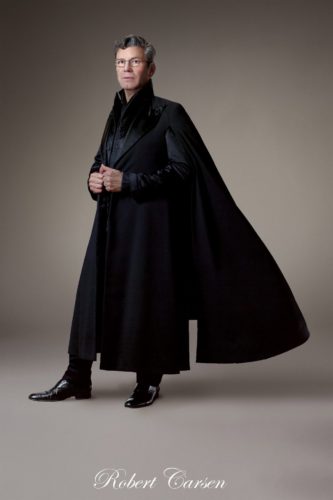
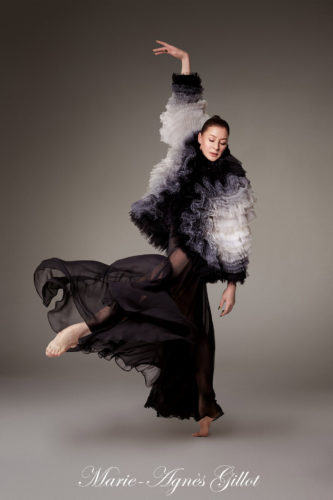
Alexis Mabille
By appointment only Alexis wanted to show his clothes himself and talk about and explain them. I’ve seen his work for many seasons and the signatures of the collection were all in evidence, the bow, this time at it boldest on a deep violet cocktail dress, the ingenue dress, for this collection in ice blue tulle layered and layered then scattered with tiny blossoms embroidered on the top layer. Alexis explains to me that the layers must still reveal a little of the wearer’s legs under the sheer and this sexiness is something totally inherent always in his work, but in a very Paris couture kind of way, never with any hint of the obvious. Then of course variations of tuxedo and tailoring with the two traditional sides of couture, flou and tailoring hourglass dress with a gold brocade tie trailing behind into ribbons and powder blue plisse underskirt, just hinting at tailoring in its crisp strapless bodice, and a tuxedo shawl collared dress merging into a deep hem of ostrich feathers. Alexis is well aware of clients and this season he photographed his collection on a series of people ranging from Jordan Roth to Betony Vernon to Audrey Marnay and Marie Agnes Gillot. True Couture must offer clients variety and in truly traditional style utilise the two sides of a house, flou and tailleur, (soft sewing and tailoring). Alexis Mabille recognises this to perfection as he speaks and explains to each visitor about the collection.
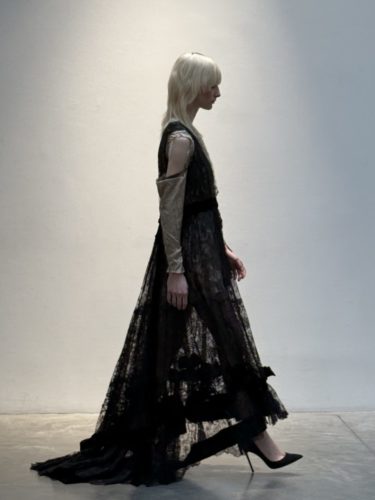
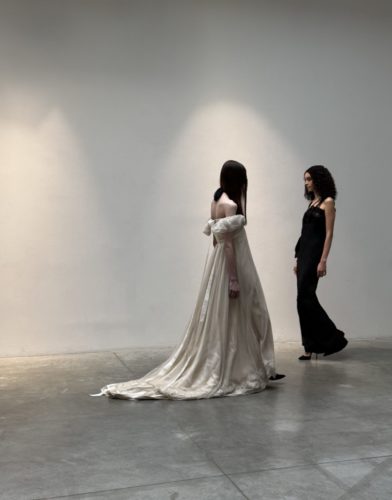
Aelis
Sofia Crociani holds my respect and admiration for the beauty of her creative vision and her commitment to a recycling/upcycling way of producing her pieces. I asked about one fragile piece which was layered over soft white, it’s jet embroidery and tulle forming a cage of nineteenth century craft over a new foundation to hold it. Sofia explained that she had embraced its frailty and faults and incorporated them into the final dress. Curating the past to be worn today, adding found pieces of fabric or trimming to contemporary fabrics offers the client a unique opportunity to purchase a true couture original, it is the only one in existence. I love the quietness of the shows, the slow pace of the presentation, the melancholy loveliness of Giselle Act Two, Chopin or a love letter tied in ivory satin ribbon found in a black velvet box. It’s truly romantic. Like the leading characters in a narrative shapes drift from Empire to Art Deco, from long and trailing to short and simple, from layered too rigorously plain. Fragile tendrils of lace or ribbon trail and drape as the model’s parade, pale and moonstruck follows midnight black. Never costume, but also never following fashion, the collection sells across the world to the discerning clients who like me know one thing; these clothes are beautiful.
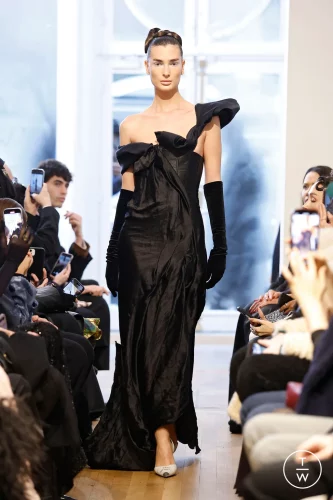
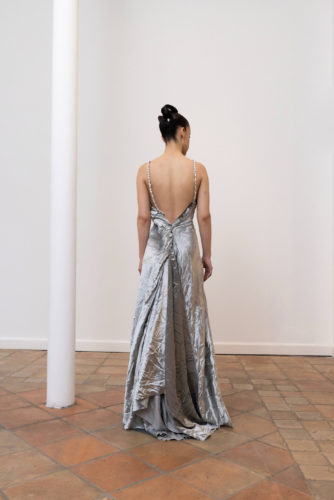
Peet Dullaert
In the tiny, Atelier Néerlandais with long narrow close to each other rows of seats, it felt special to be there to witness the presentation of the collection. I admit to being a really huge fan of Peet Dullaert and his modern couture. The heritage and techniques are observed but new ways of using them and new results invest the pieces with a modernity and a slightly subversive quality that somehow reminds me of the approach to fashion of Martin Margiela. This season the opportunity to see the clothes so close up reveals his manipulation and cutting of fabric to achieve the shapes and lines he desires, the understitching holding folds and darts in place, the twisting of the fabric to mould to the form of the model. The tiny details such as a Nile green ribbon slotted through the construction of an underlining semi corsetry piece, or the tiny edging of a crushed undulating fabric to outline the seaming. The fringed silver dress like a black and white image of a 1930’s Hollywood star with strangely flat tiny sequins randomly breaking up the fringe ends. It is all special in every detail and every idea, from casting to soundtrack, Dylan Thomas, not music, spoken of course. The creation of atmosphere through the clothes and the beauty of Pete’s aesthetic is one hundred percent individual, it demands concentration, and I believe intelligence and also an understanding of his balance between the past and the future. His thirties’ inspired looks don’t rely on Vionnet inspired cutting and simple the use of the bias, the explore how to create a line through manipulation and construction. On an ivory crepe all in one, which has a halter, but had a black slot through rouleau forming shoulder straps as well plus a deep narrow v inserted triangle of tarnished silver sequin embroidery and another slot through of a soft aniseed green taffeta bow that looped around the black and through the halter. I guess it is fashion engineering. Whatever you want to call it, in my opinion it’s beautiful and it does indeed meld the past and the future into something truly original. It’s also truly couture in its respect for craft, and the idea of made to order pieces which are unique in that every client will need the piece to be made to fit them alone.
Note. I learnt afterwards that “Do not go gentle into that good night” is in a villanelle poetry form and was actually written in Florence in 1947.
Later,
Tony Glenville
